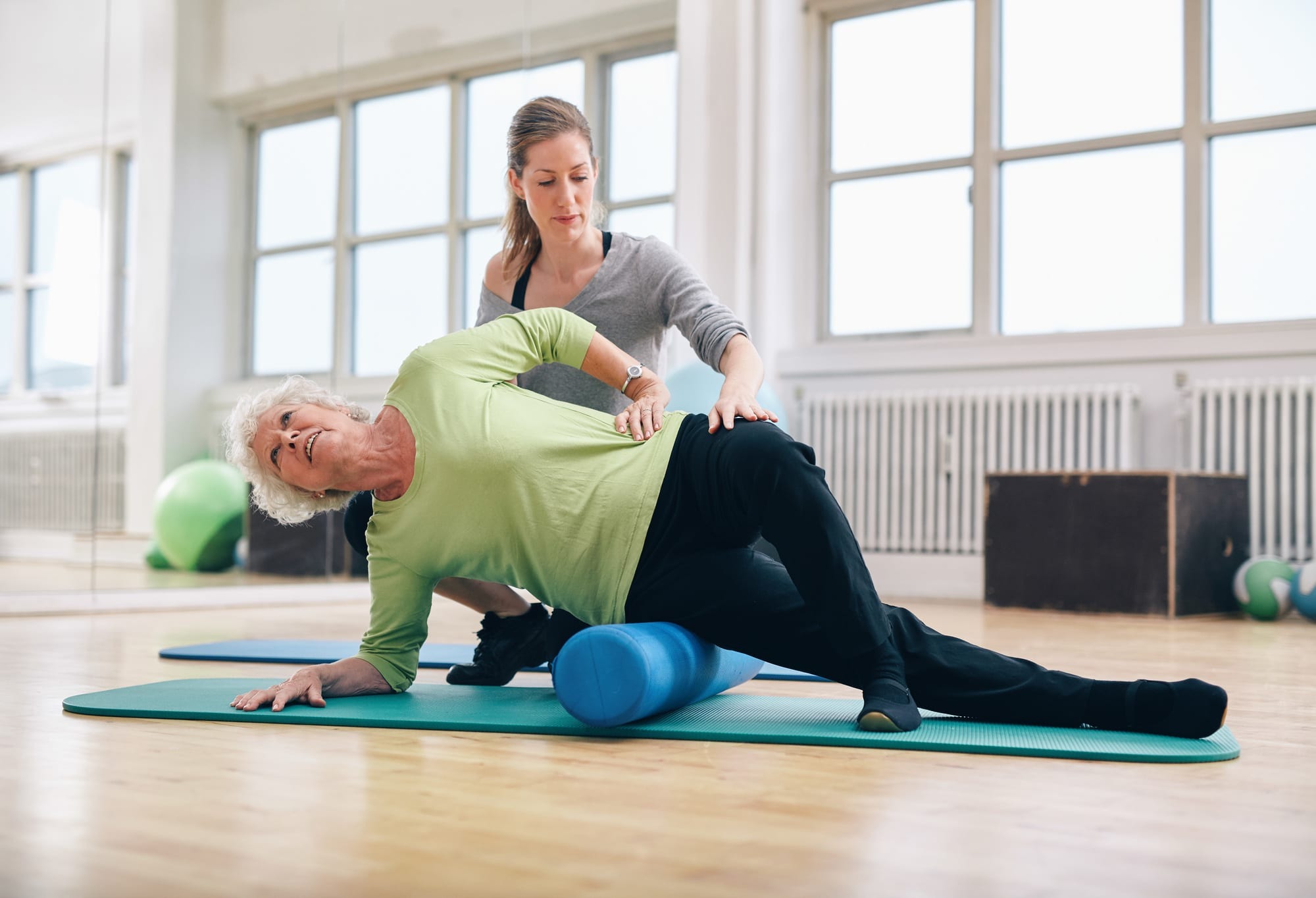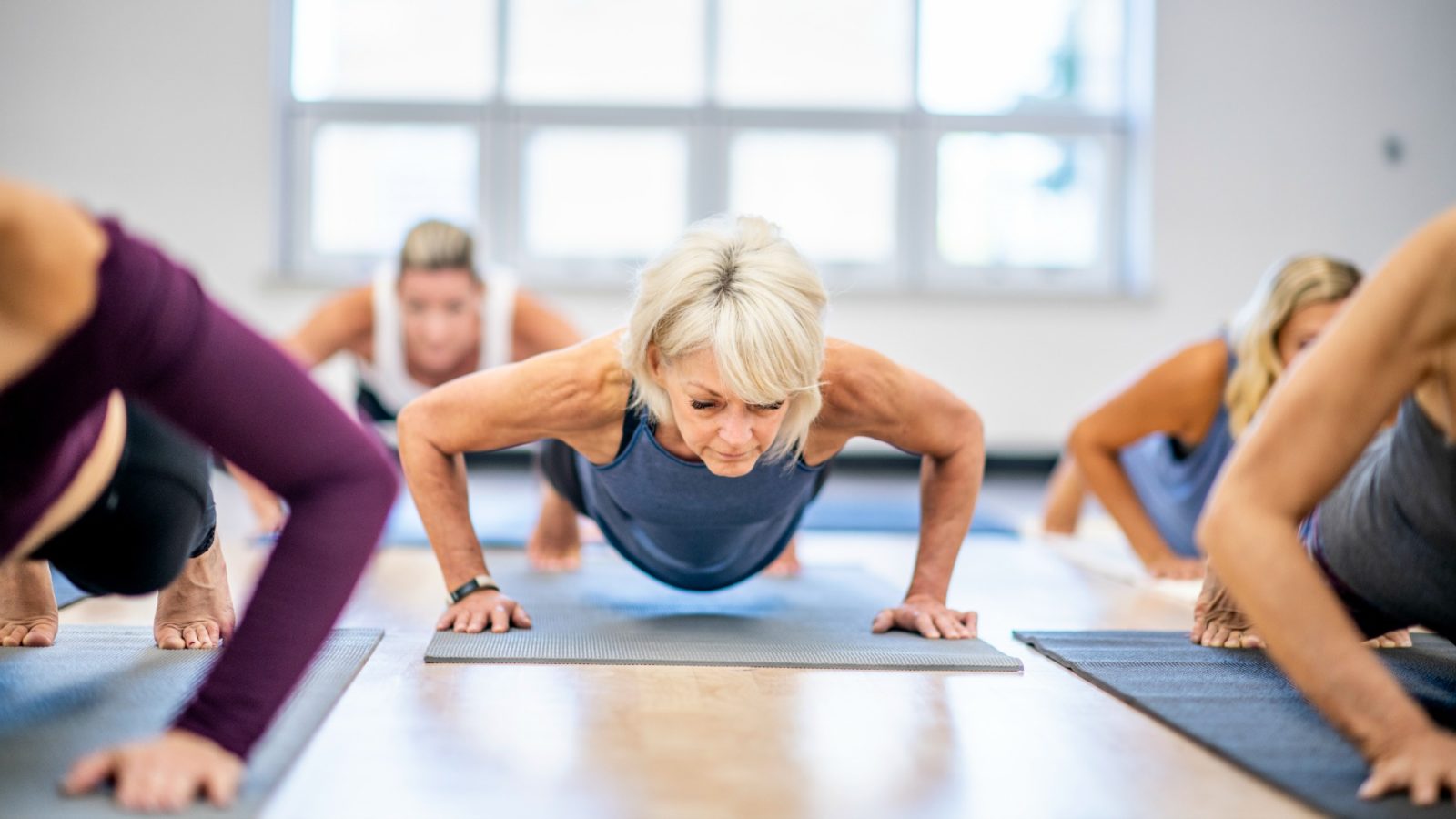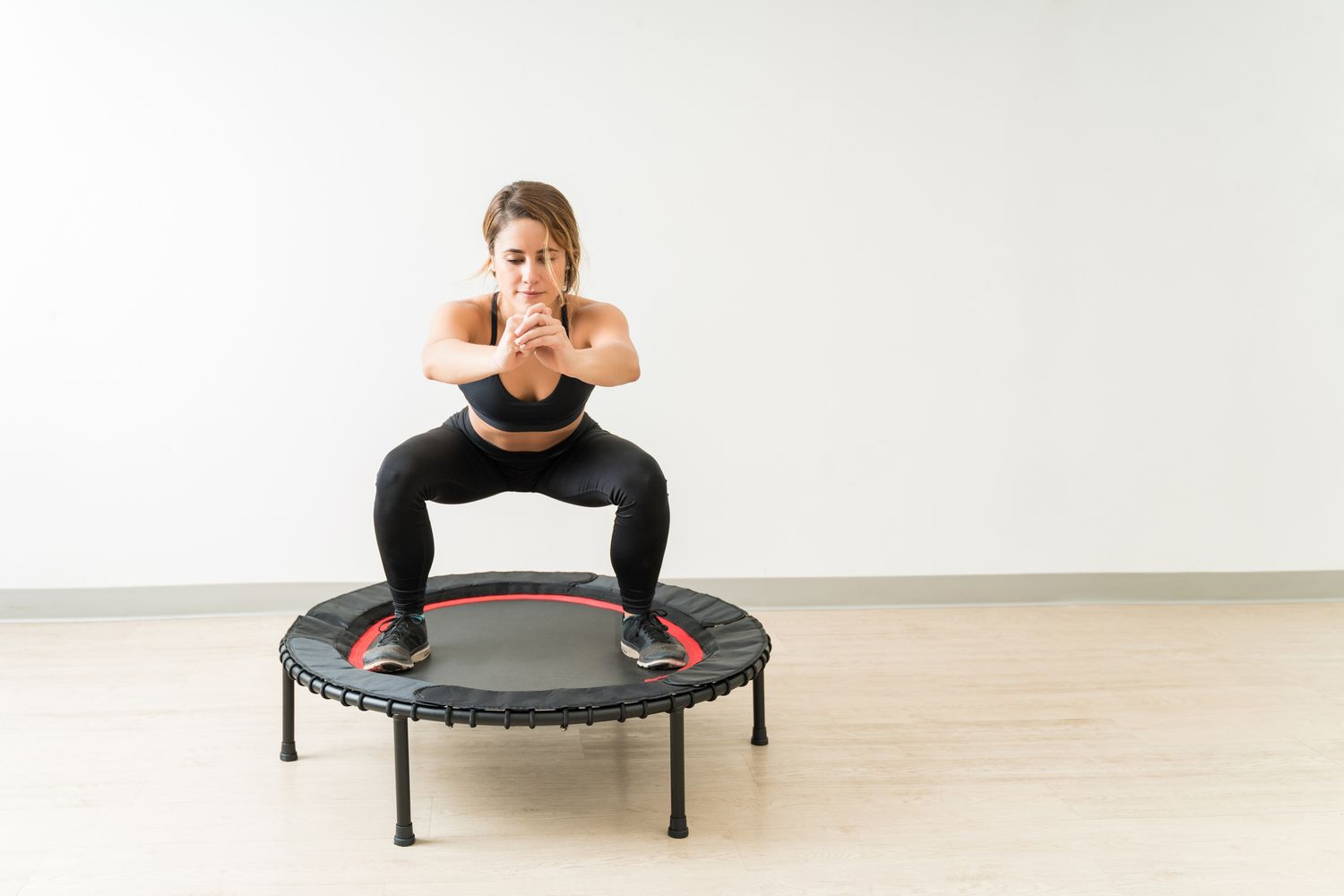

Featured
What Exercise Is Good For Osteoporosis
Published: September 30, 2023
Discover the featured exercise that is beneficial for osteoporosis. Strengthen your bones and improve your overall health with this effective workout.
Introduction
Welcome to our comprehensive guide on exercise for osteoporosis. Osteoporosis is a condition that weakens the bones, making them more prone to fractures and breaks. It affects millions of people worldwide, especially women over the age of 50. While there are various treatment options available, exercise is often recommended as a primary intervention to improve bone health and reduce the risk of fractures.
Regular exercise not only strengthens muscles and improves overall fitness, but it also helps to increase bone density and improve bone strength. In fact, the right types of exercise can be an effective way to manage osteoporosis and promote overall bone health.
In this article, we will explore the benefits of exercise for osteoporosis and the different types of exercises that are particularly beneficial. We will also discuss precautions and considerations to keep in mind when exercising with osteoporosis.
It is important to note that everyone’s situation is unique, and it is always best to consult with your healthcare provider before starting any new exercise program, especially if you have been diagnosed with osteoporosis or have any underlying health conditions.
So, if you are ready to take control of your bone health and learn how exercise can play a crucial role in managing osteoporosis, let’s dive right in!
Understanding Osteoporosis
Osteoporosis is a condition characterized by low bone density and deterioration of bone tissue, which leads to fragile and weak bones. It occurs when the body doesn’t produce enough new bone, loses too much old bone, or both. This imbalance results in porous bone, making them more susceptible to fractures even from minor falls or bumps.
While both men and women can develop osteoporosis, it is more prevalent in women, particularly after menopause. This is because estrogen, a hormone responsible for maintaining bone density, decreases significantly during menopause. Additionally, factors such as age, family history, sedentary lifestyle, inadequate calcium and vitamin D intake, smoking, excessive alcohol consumption, and certain medical conditions can increase the risk of developing osteoporosis.
It is important to note that osteoporosis is often referred to as a “silent disease” because it progresses without any noticeable symptoms until a fracture occurs. Common sites of fractures include the spine, hip, and wrist, and they can have a significant impact on an individual’s quality of life.
Diagnosing osteoporosis involves measurements of bone density using a specialized test called a bone mineral density (BMD) test. This test compares bone density to that of a healthy young adult and provides a T-score, which categorizes bone density as normal, osteopenia (low bone mass), or osteoporosis.
Now that we have a better understanding of what osteoporosis is, let’s explore how exercise can help improve bone health and reduce the risk of fractures in individuals with osteoporosis.
Benefits of Exercise for Osteoporosis
Exercise plays a crucial role in managing osteoporosis and promoting overall bone health. Regular physical activity, when done correctly and under appropriate guidance, can offer numerous benefits, including:
- Increased Bone Density: One of the primary benefits of exercise for osteoporosis is the stimulation of bone growth. Weight-bearing exercises and resistance training can help promote the deposition of new bone tissue and increase bone density. This, in turn, strengthens the bones and reduces the risk of fractures.
- Improved Muscle Strength: Exercise not only helps to build strong bones but also enhances muscle strength. Strengthening the muscles surrounding the affected joints can provide additional support and stability, reducing the risk of falls and fractures.
- Improved Balance and Coordination: Certain exercises, such as balance training and coordination drills, can help improve balance and stability. Enhanced balance reduces the risk of falls, which is particularly important for individuals with osteoporosis who may have weakened bones.
- Enhanced Posture: Osteoporosis can lead to a stooped or rounded posture due to the weakening of the vertebrae in the spine. Regular exercise, including exercises targeting the back and core muscles, can help improve posture and spinal alignment, reducing the risk of spinal fractures.
- Decreased Risk of Falls: By improving strength, balance, and coordination, exercise can significantly reduce the risk of falls, which is a common cause of fractures in individuals with osteoporosis.
It is important to note that the benefits of exercise for osteoporosis are not limited to bone health. Exercise also offers numerous cardiovascular, respiratory, and mental health benefits. Regular physical activity helps to improve cardiovascular fitness, reduce the risk of chronic diseases such as heart disease and diabetes, boost mood, and enhance overall well-being.
Now that we understand the benefits of exercise for osteoporosis, let’s explore the different types of exercises that can be particularly beneficial in managing this condition.
Types of Exercises for Osteoporosis
When it comes to exercise for osteoporosis, it is important to consider a well-rounded approach that includes a variety of different types of exercises. This ensures that you target different aspects of bone health, muscle strength, balance, and flexibility. Here are some types of exercises that can be particularly beneficial:
- Weight-Bearing Exercises: These exercises involve bearing your own body weight and include activities such as walking, dancing, jogging, stair climbing, and hiking. The impact and weight-bearing nature of these exercises stimulate bone growth and help to maintain or improve bone density.
- Resistance Exercises: Resistance exercises involve working against resistance, which can come from various sources like dumbbells, resistance bands, or your body weight. These exercises help to strengthen muscles and promote bone health. Examples include weightlifting, squats, lunges, push-ups, and tricep dips.
- Balance Exercises: Balance exercises help improve stability and reduce the risk of falls. They can include activities like standing on one leg, heel-to-toe walk, Tai Chi, and yoga poses that challenge balance and body control.
- Flexibility Exercises: Maintaining flexibility is important for joint health and preventing muscle imbalances. Stretching exercises like yoga, Pilates, and gentle stretching routines can help improve flexibility and mobility.
It is important to note that each person’s exercise routine should be tailored to their individual needs and abilities. It is recommended to work with a healthcare professional, such as a physical therapist or exercise physiologist, who can design a safe and effective exercise program for you.
Remember, consistency is key when it comes to exercise for osteoporosis. Aim for at least 150 minutes of moderate-intensity aerobic activity, along with two or more days of resistance training and balance exercises, each week. Start slowly and gradually increase the intensity and duration of your workouts, being mindful of any discomfort or pain.
Now that we have explored the different types of exercises, let’s dive deeper into each category and look at specific exercises you can incorporate into your routine to manage osteoporosis effectively.
Weight-Bearing Exercises
Weight-bearing exercises are a crucial component of an exercise regimen for osteoporosis. These exercises involve supporting your body weight through your feet and legs, which helps to stimulate bone growth and maintain or improve bone density. They can be performed both indoors and outdoors and can easily be incorporated into your daily routine. Here are some examples of weight-bearing exercises:
- Walking: Walking is a simple and accessible exercise that can be done anywhere. Aim for brisk walking for at least 30 minutes a day, preferably on different terrains to challenge your bones and muscles.
- Dancing: Dancing not only gets your heart pumping but also engages your whole body. Whether it’s ballroom dancing, Zumba, or even dancing in the comfort of your own home, it’s a fun and effective weight-bearing exercise.
- Jogging and Running: If you have the fitness level, incorporating jogging or running into your exercise routine can provide a higher impact weight-bearing activity. Start gradually and build up your endurance over time.
- Stair Climbing: Climbing stairs is an excellent weight-bearing exercise that targets your leg muscles and helps to strengthen the bones in your lower body. If you don’t have stairs available, you can use a stair climber machine at the gym.
- Hiking: Taking a hike not only allows you to enjoy nature but also provides a great opportunity for weight-bearing exercise. Look for hiking trails with varying levels of difficulty to challenge yourself.
Remember to wear appropriate footwear that provides proper support and cushioning during these weight-bearing exercises. It is crucial to start slowly and gradually increase the intensity and duration of your workouts, especially if you’re new to exercise or have been inactive for a while. Listening to your body and taking rest days when needed is equally important to prevent overuse injuries.
It’s also worth noting that weight-bearing exercises can be combined with other types of exercises, such as resistance training, to further enhance bone health and overall fitness. The next section will delve into resistance exercises for osteoporosis.
Resistance Exercises
Resistance exercises, also known as strength training or weightlifting, are an important component of an exercise program for osteoporosis. These exercises involve working against resistance, such as weights, resistance bands, or your body weight, to strengthen and build muscle. Resistance exercises provide numerous benefits for bone health, muscle strength, and overall function. Here are some examples of resistance exercises:
- Weightlifting: Using dumbbells, barbells, or weight machines at the gym, you can perform exercises that target different muscle groups, such as bicep curls, chest presses, and shoulder presses. Start with light weights and progressively increase the resistance as your strength improves.
- Bodyweight Exercises: You don’t necessarily need fancy equipment to do resistance exercises. Exercises like squats, lunges, push-ups, planks, and tricep dips utilize your body weight to provide resistance. These exercises can be easily modified to suit your fitness level and can be done at home or in a gym.
- Resistance Bands: Resistance bands are versatile and portable, making them a convenient tool for resistance training. They come in various resistances, allowing you to gradually increase the intensity as you become stronger. You can perform exercises like bicep curls, rows, and chest presses using resistance bands.
- Functional Movements: Incorporating functional movements into your resistance training routine can help improve overall strength and stability. Exercises that mimic everyday activities, such as squats, deadlifts, and step-ups, improve muscle coordination and enhance functional fitness.
- Pilates and Yoga: Pilates and yoga are excellent forms of resistance exercise that focus on strengthening the core, improving flexibility, and enhancing body awareness. These exercises can be adapted to individual abilities and modified to support bone health.
When performing resistance exercises, it’s important to maintain proper form and technique to prevent injury. Start with lighter weights or resistance bands and focus on mastering the movement before progressing to heavier weights or increased resistance. It’s also beneficial to work with a qualified trainer or participate in a supervised class to ensure proper technique and guidance.
Remember, consistency is key when it comes to resistance training. Aim for at least two to three sessions per week, targeting all major muscle groups. Allow for adequate rest between workouts to allow for muscle recovery. As with any exercise program, it’s important to listen to your body and modify exercises as needed to accommodate any physical limitations or discomfort.
Now that we’ve covered resistance exercises, let’s move on to discuss the importance of balance exercises for individuals with osteoporosis.
Balance Exercises
Balance exercises are an essential component of an exercise regimen for individuals with osteoporosis. These exercises help improve stability, coordination, and proprioception, reducing the risk of falls and fractures. Balance exercises specifically target the muscles involved in maintaining balance and can be easily incorporated into your daily routine. Here are some examples of balance exercises:
- Single Leg Stands: Stand on one leg while keeping your core engaged and your other leg lifted slightly off the ground. Start with a stable surface and gradually progress to standing on an unstable surface, such as a foam pad or Bosu ball. Hold the position for 30 seconds to a minute and switch legs.
- Heel-to-Toe Walk: Walk in a straight line, placing the heel of one foot directly in front of the toes of the opposite foot. This exercise challenges your balance and coordination. Take it a step further by performing the heel-to-toe walk on an uneven surface, such as a balance beam or a line drawn on the ground.
- Tai Chi: Tai Chi is a gentle form of exercise that combines flowing movements and deep breathing. It promotes relaxation, balance, and body awareness. Practicing Tai Chi regularly can enhance stability and reduce the risk of falls.
- Yoga Balance Poses: Yoga poses like tree pose, warrior III, and eagle pose help improve balance, strength, and flexibility. These poses require concentration and engagement of the core and lower body muscles, making them effective for improving balance.
- Bosu Ball Exercises: A Bosu ball is a half-dome stability tool that can be used for a variety of balance exercises. By standing, sitting, or lying on the Bosu ball, you engage your stabilizing muscles, challenging your balance and proprioception.
When performing balance exercises, make sure you have a sturdy support nearby, such as a wall or a chair, to provide stability if needed. Start with exercises that are appropriate for your current balance level and gradually increase the difficulty as your balance improves.
It’s important to note that balance exercises can be integrated with other types of exercises. For example, performing resistance exercises while standing on one leg or using a balance board can further challenge your balance and target multiple muscle groups simultaneously.
By incorporating balance exercises into your routine, you can improve your overall stability, minimize the risk of falls and fractures, and enhance your confidence in daily activities.
Next, let’s discuss the importance of flexibility exercises for individuals with osteoporosis.
Flexibility Exercises
Flexibility exercises are an important component of an exercise program for individuals with osteoporosis. These exercises help improve range of motion, joint mobility, and muscle elasticity, which are crucial for maintaining proper posture, preventing muscle imbalances, and reducing the risk of injuries. Flexibility exercises can be gentle and easily adapted to individual abilities. Here are some examples of flexibility exercises:
- Yoga: Yoga incorporates a combination of stretching, breathing, and relaxation techniques. It helps improve flexibility, balance, and body awareness. Yoga poses, such as seated forward bends, standing stretches, and spinal twists, target different muscle groups and promote flexibility.
- Pilates: Pilates focuses on core strength, flexibility, and body alignment. The controlled movements and emphasis on proper body mechanics help improve flexibility while promoting overall stability and strength.
- Stretching: Gentle stretching exercises should be performed regularly to maintain or improve flexibility. These can include stretches for the major muscle groups, such as calf stretches, hamstring stretches, chest stretches, and shoulder stretches. Holding each stretch for 15-30 seconds and repeating each stretch 2-3 times can help improve muscle flexibility.
- Range of Motion Exercises: Range of motion exercises involve moving a joint through its full range of motion. These exercises help maintain joint flexibility and reduce the risk of stiffness. Examples include shoulder circles, ankle rotations, and neck side bends.
- Foam Rolling: Foam rolling, also known as self-myofascial release, is a self-massage technique using a foam roller. It helps release tension, improve blood flow, and increase flexibility. Foam rolling can be beneficial for targeting specific tight areas, such as the calves, quadriceps, and upper back.
When performing flexibility exercises, it’s important to prioritize proper form and technique. Warm up your muscles before stretching and breathe deeply throughout each stretch, allowing your body to relax and gently deepen the stretch as you exhale. Avoid bouncing or jerking movements, as these can lead to injury.
Remember, flexibility exercises should be done in a pain-free range of motion. If you have any joint or muscle problems, it’s important to work with a healthcare professional or a qualified exercise specialist to ensure that you’re performing the appropriate stretches for your condition.
By incorporating flexibility exercises into your routine, you can improve joint mobility, enhance muscle flexibility, and reduce the risk of muscle imbalances. This, in turn, promotes optimal posture, movement efficiency, and overall function.
Now that we’ve covered flexibility exercises, let’s move on to discuss important precautions and considerations when exercising with osteoporosis.
Precautions and Considerations
When engaging in exercise to manage osteoporosis, there are several precautions and considerations to keep in mind to ensure your safety and maximize the benefits. Here are some important factors to consider:
- Consult with your healthcare provider: Before starting any exercise program, especially if you have been diagnosed with osteoporosis or have any underlying health conditions, it’s important to consult with your healthcare provider. They can provide personalized recommendations and ensure that exercise is safe and appropriate for your specific needs.
- Start slowly and progress gradually: If you’re new to exercise or have been inactive for a while, it’s essential to start slowly and gradually increase the intensity and duration of your workouts. This allows your body to adapt to the demands of exercise and reduces the risk of injuries. Listen to your body and take breaks or modify exercises as needed.
- Choose low-impact exercises: While exercise is beneficial for osteoporosis, it’s important to choose low-impact exercises to minimize stress on your joints and reduce the risk of fractures. Activities like walking, swimming, cycling, and using elliptical machines are generally safe and effective options.
- Avoid high-impact exercises: High-impact exercises, such as running, jumping, or activities with rapid changes in direction, may increase the risk of fractures, especially if you have severe osteoporosis or a history of fractures. It’s best to seek guidance from a healthcare professional to determine whether high-impact exercises are appropriate for you.
- Use proper form and technique: Performing exercises with proper form and technique is essential to prevent injuries and maximize the benefits. If you’re unsure about a specific exercise, consider working with a qualified fitness professional who can guide you and ensure you’re using the correct form.
- Be mindful of pain and discomfort: While exercise may lead to some muscle soreness, it’s important to differentiate between muscle soreness and sharp or prolonged pain. If you experience any unusual pain or discomfort during or after exercise, stop and seek advice from a healthcare professional.
It’s worth noting that individual considerations and restrictions may vary depending on the severity of your osteoporosis and any other health conditions you may have. Working with a healthcare professional or a qualified exercise specialist can provide you with personalized guidance and modifications to ensure you exercise safely and effectively.
By following these precautions and considerations, you can minimize the risk of injury and optimize the benefits of exercise for osteoporosis.
Now that we’ve covered important precautions, let’s conclude our article and summarize the key points we’ve discussed.
Conclusion
Osteoporosis is a condition that requires proactive management to maintain bone health and reduce the risk of fractures. Exercise plays a vital role in this management by improving bone density, muscle strength, balance, and flexibility. By incorporating a variety of exercises into your routine, you can effectively target different aspects of bone health and overall fitness.
Weight-bearing exercises, such as walking, dancing, and jogging, stimulate bone growth and increase bone density. Resistance exercises, including weightlifting and bodyweight exercises, strengthen muscles and enhance bone health. Balance exercises improve stability and reduce the risk of falls, while flexibility exercises maintain joint mobility and prevent muscle imbalances.
While engaging in exercise for osteoporosis, it is crucial to take precautions and consider individual factors. Consulting with your healthcare provider, starting slowly, using proper form, and listening to your body are all important considerations. Low-impact exercises are generally safe, while high-impact activities may need to be evaluated on an individual basis.
Remember that everyone’s circumstances are unique, and it is crucial to work with healthcare professionals to develop a personalized exercise plan based on your specific needs and abilities.
By incorporating exercise into your routine and following these guidelines, you can take an active role in managing your osteoporosis, improving bone health, preventing fractures, and enhancing overall well-being.
So, get moving, stay consistent, and enjoy the many benefits that exercise can bring to your life!









